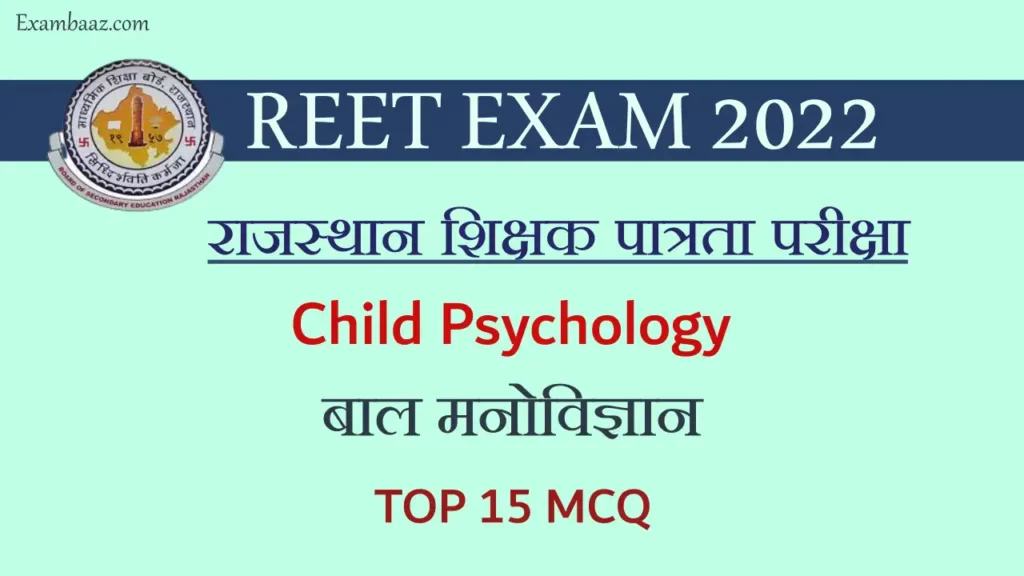REET 2022 Child Psychology MCQ: राजस्थान में रीट परीक्षा का आयोजन 23 और 24 जुलाई को किया जाएगा जिसमें शिक्षक बनने का सपना लिए लाखों की संख्या में अभ्यर्थी शामिल होंगे, अब देखा जाए तो परीक्षा में केवल 5 दिन का समय शेष है अभ्यर्थियों को इस बचे हुए समय का उचित लाभ लेते हुए रिवीजन पर अधिक फोकस करना बेहद आवश्यक है ताकि बेहतर परिणाम प्राप्त किया जा सके परीक्षा की तैयारी कर रहे हमारे द्वारा नियमित रूप से विभिन्न विषयों से संबंधित प्रैक्टिस सेट उपलब्ध करवाए जा रहे हैं आज के आर्टिकल में हम ‘बाल मनोविज्ञान’ से जुड़े कुछ महत्वपूर्ण प्रश्न लेकर आएं, जिन्हें आपको परीक्षा हॉल में जाने से पूर्व एक नजर अवश्य पढ़ना चाहिए.
बाल मनोविज्ञान के इन सवालों से करें रीट परीक्षा की पक्की तैयारी—Child Psychology Important MCQ Question for REET Exam 2022 level 1 and 2
1.संरक्षण, संबंध तथा वर्गीकरण जैसे संप्रदाय का विकास निम्नांकित में से किस अवस्था में होता है? /In which of the following stages does the development of a community such as conservation, relation and classification take place?
(a) संवेदीपेशीय अवस्था/Sensorineural state
(b) ठोस संक्रिया की अवस्था/State of solid operation
(c) औपचारिक संक्रिया की अवस्था/Stage of formal operation.
(d) प्राक् संक्रियात्मक अवस्था/Pre-operational stage
Ans- b
2. सभी चिंतन प्रक्रियाएँ अनिवार्यतः आधारित होती हैं -/All thought processes are essentially based on –
(a) पेशीय व्यवहार पर /On muscular behavior
(b) स्वली चिंतन पर/Self thinking
(c) सीखना पर/On learning
(d) समस्या समाधान पर/On problem solving
Ans- d
3. निम्नांकित में से किसमें नियंत्रित, क्रियाशील, सभिप्राय तथा लक्ष्योन्मुखी चिंतन सम्मिलित होता है?/ Which of the following involves controlled, actionable, intentional and goal-oriented thinking?
(a) विभेदन/Differentiation
(b) कल्पना/Imagination
(c) तर्कणा/Reasoning
(d) निर्णयशीलता/Decision-making
Ans- c
4. सूक्ष्म शिक्षण चक्र का प्रथम पद होता है -/The first step of the micro-teaching cycle is –
(a) प्रतिपुष्टि/Feedback
(b) शिक्षण/Teaching
(c) योजना बनाना /Planning
(d) प्रस्तावना/Preface
Ans- c
5. शिक्षण के संबंध में निम्न में से कौनसा क्रम सही है -/Which of the following sequence is correct regarding teaching?
(a) स्मरण करना, बोधगम्य करना, चिंतन करना।/To remember, to understand, to Thinking
(b) बोधगम्य करना, स्मरण करना, चिंतन करना। /To understand, to remember, to Thinking.
(c) चिंतन करना, स्मरण करना, बोधगम्य करना।/To Thinking, to remember, to understand.
(d) इनमें से सभी /all of these
Ans- a
6. ‘निदान’ का अर्थ है, अधिगम संबंधी कठिनाइयों और कमियों के स्वरूप का निर्धारण। यह कथन है -/’Diagnosis’ means determining the nature of learning difficulties and deficiencies. this statement-
(a) ब्राउन/Brown
(b) सिम्पसन /Simpson
(c) गुड/Good
(d) स्टीवर्ट/Stewart
Ans- c
7. जब पहले के सीखने का प्रभाव किसी नई अनुक्रिया के निष्पादन का सीखने पर पड़ता है तो सीखने का अंतरण कहलाता है परिभाषा है -/When the performance of a new response has an effect on learning from earlier learning, it is called transfer of learning.
(a) कोलसनिक /Colsanic
(b) क्रो एंड क्रो/Crow and Crow
(c) सोरेन्सन /Sorenson
(d) ब्लेयर, जोन्स, सिम्पसन /Blair, Jones, Simpson
Ans- d
8. फ्रायड के अनुसार व्यक्ति में सभी तरह के रचनात्मक कार्यों का प्रेरणा स्त्रोत निम्नांकित में से कौनसा होता है?/According to Freud, which one of the following is the source of inspiration for all kinds of creative work in a person?
(a) चिंता/Anxiety
(b) एरोस/Eros
(c) थैनाटोस/Thanatos
(d) अचेतन/unconscious
Ans- b
9.एक सफल शिक्षक वह है जो हो – /A successful teacher is one who is
1. दयालु एवं अनुशासनवादी /Compassionate and Disciplinarian
2. शांत एवं प्रतिक्रियाशील/Calm and Reactive
3. सहनशील एवं प्रभुत्ववादी /Tolerant and Dominant
4. निष्क्रिय एवं सक्रिय/Passive and Active
ऊपर दिए गए कोड से सही उत्तर का चयन कीजिए -Select the correct answer from the codes given above –
(a) 1 और 2
(b) 3 और 4
(c) केवल 1
(d) केवल 3
Ans- c
10. अनुबंधित उद्दीपकों को कितने भागों में विभाजित किया जा सकता है/ Into how many parts can contracted stimuli be divided?
(a) 2
(b) 3
(c) 4
(d) 5
Ans- a
11. बंद जगहों से अयुक्तिसंगत भय को कहा जाता है -/The unreasonable fear of closed spaces is called –
(a) एक्रोफोबिया /phobia
(b) क्लाउस्ट्रोफोविया/Claustrophobia
(c) एगोराफोविया/Agorafobia
(d) माइसोफोविया /Mysofobia
Ans- b
12. EPPS जो मानव आवश्यकताओं का मापन करता है, एक तरह का -/EPPS which measures human needs, is a kind of –
(a) प्रक्षेपी प्रविधि है।/Projective technique
(b) प्रश्नावली प्रविधि है।/Questionnaire technique.
(c) प्रेक्षण विधि है। /Observation method.
(d) परिस्थितिजन्य विधि है। /Situational method
Ans- b
13. अधिगम की संज्ञानवादी विचारधारा से संबंधित मनोवैज्ञानिक नहीं है -Psychologically not related to the cognitiveist ideology of learning
(a) हल/Hull
(b) कोहलर /Kohler
(c) ब्रूनर/Brunner
(d) टोलमैन/Tolman
Ans- a
14.राष्ट्रीय पाठ्यचर्या रूपरेखा 2005 में भारत की धार्मिक एवं सांस्कृतिक विविधता को मानना, स्त्रियों के प्रति सम्मान एवं जिम्मेदारी के दृष्टिकोण को बढ़ाने के प्रोग्राम का आयोजन एवं वृत्त चित्र तथा फिल्मों का एकत्र करना एंव दिखाना जिनके माध्यम से न्याय एवं शांति में वृद्धि हो, को सुझाया गया है ताकि -/ Recognizing India’s religious and cultural diversity in the National Curriculum Framework, 2005, organizing programs to increase the attitude of respect and responsibility towards women and collecting and showing documentaries and films through which justice and peace are increased, It is suggested that –
(a) शांति की शिक्षा दी जा सके /Peace can be taught
(b) मूल्यों की शिक्षा दी जा सके/Values can be taught
(c) नागरिकता की शिक्षा दी जा सके /Citizenship can be taught
(d) इनमें से कोई नहीं /None of these
Ans- a
15. जिस सामान्य मानसिक क्षमता के सहारे गणितीय संकेत, चिन्हों, आकृतियों के आपसी संबंध का अध्ययन किया जाता है, उसे कहा जाता है -The general mental ability with the help of which the relationship between mathematical signs, signs, figures is studied is called –
(a) सामाजिक बुद्धि /Social intelligence
(b) अमूर्त्त बुद्धि /Abstract intelligence
(c) मूर्त्त बुद्धि /Concrete intelligence
(d) शाब्दिक बुद्धि/Verbal intelligence
Ans- b
Read more:
यहां हमने REET परीक्षा के लिए ‘बाल मनोविज्ञान’ पूछे जाने वाले (REET 2022 Child Psychology MCQ) महत्वपूर्ण प्रश्नों का अध्ययन किया रीट परीक्षा से जुड़ी सभी नवीनतम अपडेट तथा प्रैक्टिस सेट प्राप्त करने के लिए आप हमारे टेलीग्राम चैनल के सदस्य जरूर बने जॉइन लिंक नीचे दी गई है।

